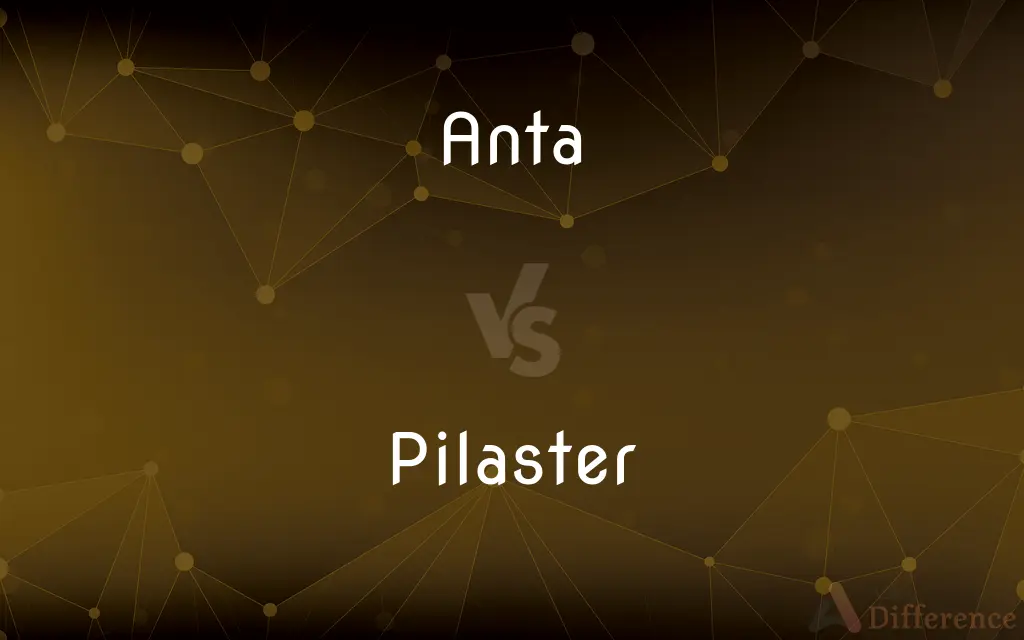Anta vs. Pilaster — What's the Difference?
By Tayyaba Rehman & Urooj Arif — Updated on April 20, 2024
Anta supports the end of a building, often integrated into its walls; whereas, a pilaster is a decorative, flattened column attached to a wall for ornamental or structural support.

Difference Between Anta and Pilaster
Table of Contents
ADVERTISEMENT
Key Differences
An anta is architecturally used at the end of the walls of a building, often blending seamlessly with the structure, while a pilaster, though it mimics the appearance of a column, is primarily ornamental and attached to the wall.
Antas are prominent in classical Greek and Roman temple architectures, providing structural integrity and defining the edges of buildings, whereas pilasters are used across various architectural styles, including Renaissance and Baroque, enhancing the aesthetic appeal and occasionally offering support.
The design of an anta is usually plain and directly connected to the masonry of walls, focusing on strength and continuity. In contrast, pilasters can be highly decorative, featuring ornate capitals and bases that echo free-standing columns.
Antas typically support the roof or frame the temple’s entrance, directly contributing to the building's functionality. Pilasters, on the other hand, may also support architectural elements like arches or entablatures, but they are often used to create a rhythm or visual interest on an otherwise flat wall.
The placement of antas is strictly functional and determined by structural needs, while the placement of pilasters can be flexible, designed to meet aesthetic goals or to imply a more classical architecture.
ADVERTISEMENT
Comparison Chart
Function
Structural support
Decorative and/or structural
Appearance
Blends with the wall
Stands out from the wall
Architectural Styles
Classical Greek and Roman
Varied, including Renaissance and Baroque
Decorative Elements
Minimal or none
Often elaborate
Main Use
Support at building ends
Visual interest or rhythm
Compare with Definitions
Anta
A structural piece integrated into the masonry of a building.
Each anta was carefully aligned with the roof structure.
Pilaster
Serves aesthetic purposes, sometimes structural.
The addition of pilasters broke the monotony of the long corridor.
Anta
Primarily seen in classical architecture.
Ancient Greek temples often utilize antas as corner supports.
Pilaster
A flat, rectangular column attached to a wall, often decorative.
The façade is enhanced by evenly spaced pilasters.
Anta
A vertical architectural element forming the ends of a wall.
The temple featured prominent antas framing its main façade.
Pilaster
Can be used to support or appear to support architectural elements.
Pilasters add depth to the building’s design by supporting the cornice.
Anta
Supports the lintel in a doorway or porch.
The antas at the porch entrance bear the weight of the overhead lintel.
Pilaster
Common in more elaborately decorated architectural styles.
Baroque churches are richly decorated with sculpted pilasters.
Anta
Linked directly to the functionality of the structure.
The structural integrity provided by the antas is crucial for the temple's longevity.
Pilaster
Mimics the form of a standalone column but is non-structural.
Despite their column-like appearance, the pilasters are purely ornamental.
Anta
A pilaster forming the end of a projecting lateral wall, as in some Greek temples, and constituting one boundary of the portico.
Pilaster
In classical architecture, a pilaster is an architectural element used to give the appearance of a supporting column and to articulate an extent of wall, with only an ornamental function. It consists of a flat surface raised from the main wall surface, usually treated as though it were a column, with a capital at the top, plinth (base) at the bottom, and the various other column elements.
Anta
(architecture) A kind of pier produced by thickening a wall at its termination, treated architecturally as a pilaster, with capital and base.
Pilaster
A rectangular column with a capital and base, projecting only slightly from a wall as an ornamental motif.
Anta
A species of pier produced by thickening a wall at its termination, treated architecturally as a pilaster, with capital and base.
Pilaster
A rectangular column that projects partially from the wall to which it attached; it gives the appearance of a support, but is only for decoration.
Pilaster
A column or short wing wall attached to the foundation wall which provides lateral support, or to support a vertical load that does not fall on the foundation wall.
Pilaster
An upright architectural member right-angled in plan, constructionally a pier (See Pier, 1 (b)), but architecturally corresponding to a column, having capital, shaft, and base to agree with those of the columns of the same order. In most cases the projection from the wall is one third of its width, or less.
Pilaster
A rectangular column that usually projects about a third of its width from the wall to which it is attached
Common Curiosities
Where are antas commonly found?
Antas are commonly found in the architecture of ancient Greek and Roman temples.
What is a pilaster?
A pilaster is a decorative architectural feature resembling a flat column attached to a wall, providing visual interest and sometimes support.
How do antas differ from columns?
Antas are integrated into wall ends and support structures directly, unlike free-standing columns.
Are pilasters found in modern architecture?
Yes, pilasters are used in modern architecture, often as decorative elements.
Can pilasters be structural?
Yes, pilasters can provide structural support, though they are often used decoratively.
What styles use pilasters most?
Pilasters are prominent in Renaissance, Baroque, and Neoclassical architecture.
What is an anta?
An anta is a structural element at the ends of a wall in classical architecture, supporting significant architectural loads.
Do antas have decorative features?
Antas are generally more functional and less decorative than pilasters.
What materials are used to make antas?
Antas are typically made from the same materials as the building, often stone or brick.
How do pilasters enhance architectural design?
Pilasters add depth and rhythm to flat walls, enhancing the overall aesthetic.
Is there a structural advantage to using antas?
Yes, antas provide essential support at critical structural points, particularly in large buildings.
How does the visual impact of antas and pilasters differ?
Antas are subtle and blend with the architecture, while pilasters are designed to stand out.
Can pilasters be functional in modern construction?
In modern construction, pilasters can be both functional and decorative, depending on the design.
What is the primary function of antas in historical buildings?
In historical buildings, antas primarily serve to structurally support the ends of walls and frame entrances.
What is the origin of the pilaster design?
The design originates from classical columns, adapted for attachment to walls.
Share Your Discovery

Previous Comparison
Antiquity vs. Vetust
Next Comparison
Deft vs. DeftlyAuthor Spotlight
Written by
Tayyaba RehmanTayyaba Rehman is a distinguished writer, currently serving as a primary contributor to askdifference.com. As a researcher in semantics and etymology, Tayyaba's passion for the complexity of languages and their distinctions has found a perfect home on the platform. Tayyaba delves into the intricacies of language, distinguishing between commonly confused words and phrases, thereby providing clarity for readers worldwide.
Co-written by
Urooj ArifUrooj is a skilled content writer at Ask Difference, known for her exceptional ability to simplify complex topics into engaging and informative content. With a passion for research and a flair for clear, concise writing, she consistently delivers articles that resonate with our diverse audience.














































